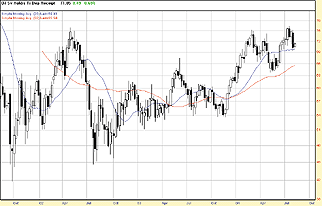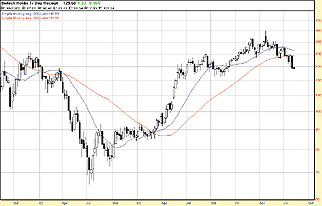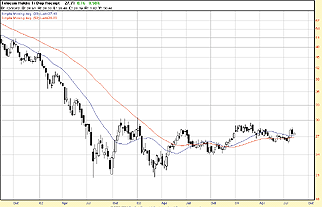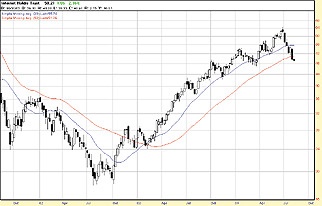HOLDRs, or Holding Company Depositary Receipts, are exchange-traded products created by Merrill Lynch & Co. that allow individual investors and institutions to own a basket of common stocks from companies within a specific industry or market sector. Unlike other exchange-traded products, HOLDRs investors have ownership rights to the underlying stocks in a given HOLDR should they choose to exercise them (a process called "canceling"). The component stocks of individual HOLDRs are selected based on market capitalization, liquidity, price/earnings ratio, and other factors. Component stocks may be equally weighted in a given HOLDR, or weighted based on market capitalization.
OIL SERVICE HOLDERS

The Oil Service HOLDRs (OIH) are designed to provide investors with exposure to companies involved in the drilling, production, and refinement of petroleum products. OIH components include Baker Hughes, Halliburton, Global Santa Fe, Transocean Sedco Forex, and Schlumberger Ltd.
The OIH emerged from a volatile, but overall bullish, market in 2003 to set major new highs in the summer of 2004 as energy prices surged. Breaking out over its 20-week simple moving average in the fourth quarter of 2003, OIH corrected into the second quarter of the year but found support on its 50-week simple moving average. It was the rally from this support that has allowed the OIH to perform so well into 2004, when other markets were failing.
What they say: "Fear of potential supply disruption could push oil prices above $50... Only President Bush can reverse the runaway price by releasing oil from the Strategic Petroleum Reserve. The longer oil prices remain high the greater the economic damage. We think the upside potential in oil and gas stocks is not greater than the downside risk." -John Cusick, research analyst for Oppenheimer & Co., as quoted in "Oil stocks higher; crude backs off $45," by Lisa Sanders of CBS Marketwatch.com: August 10, 2004.
BIOTECH HOLDRS

The Biotech HOLDRs (BBH) are designed to provide investors with exposure to companies involved in the biotechnology industry. BBH components include Amgen, Genentech, Biogen Idec, Gilead Sciences, and MedImmune.
The BBH broke out above its 20-week simple moving average in the fourth quarter of 2002 and moved above its 50-week simple moving average late in the first quarter of 2003 - just as the 20-week SMA was moving above the 50-week. This bullish development led to a major rally in biotechnology stocks in 2003. While advancing during the first quarter of 2004, biotechnology stocks appeared to top out by spring, with the BBH falling beneath its 20-week SMA. With summer trading taking the BBH below its 50-week SMA, traders are likely to look for support near the lows of the third and fourth quarters of 2003.
What they say: "Spurned across the continent by food-fastidious Europeans, the biotechnology industry has turned to the ultimate icebreaker: genetically modified beer. A consortium of the world's largest biotech companies, led by Monsanto, helped fund a Swedish brewer's new light lager that's produced with the usual hops and barley - and a touch of genetically engineered corn." -from "Beer: Hops, barley... and biotech?" Wired News Report: July 9, 2004.
TELECOM HOLDERS

The Telecom HOLDRs (TTH) are designed to provide investors with exposure to companies involved in the telecommunications industry. TTH components include SBC Communications, Verizon, Qwest, BellSouth, and Sprint.
The TTH has been mired in a slowly contracting trading range since the deep declines of the summer and autumn of 2002. While prices for the TTH have rallied above their now largely flat 20- and 50-week simple moving averages in the second quarter of 2003 and again in the first quarter of 2004, it will likely take a strong move above the fourth-quarter 2002 highs before bulls are truly ready to commit to telecom stocks.
What they say: "Qwest Communications has managed to become the most hated telecommunications stock in all the land - quite a distinction in a sector that has drawn mostly scorn from investors this year. Shares of Qwest, a product of the misbegotten marriage of Baby Bell US West and the fiber-optic firm Qwest, have lost 38% of their market value in 2004, after a drop of 30% to 2.69 last week. Even the nasty 30% drop in AT&T shares this year can't quite compare, for sheer ugliness." -Michael Santoli, "Market at '04 lows on poor economic news," The Trader, Barron's Online: August 9, 2004.
INTERNET HOLDRS

The Internet HOLDRs (HHH) are designed to provide investors with exposure to companies involved in the Internet industry. HHH components include eBay, Yahoo!, Time Warner, Amazon.com, and E*Trade Group.
The HHH was one of the strongest performers in 2003. After breaking out above its 20-week simple moving average in the fourth quarter of 2002, and besting its 50-week simple moving average for good in the first quarter of 2003, the HHH more than doubled in value between the start of the year and the beginning of the fourth quarter. Further gains were to be had by HHH, which continued to advance into 2004, even as other markets began to fade. By the beginning of the third quarter of 2004, however, it appeared as if the HHH was itself beginning to lose steam, as it slipped below both its 20- and 50-week simple moving averages.
What they say: "After five-plus years of largely glowing coverage from the press, Google and its executives must feel like they've entered a shooting gallery. Once billed as the initial public offering of the decade, Google's bid to go public has been hampered of late by missteps, downbeat press reports, and a suddenly grisly market." -Ben Elgin, "Google: Will blunders rock its float?", BusinessWeek Online, August 9, 2004.
- Prophet Financial Systems
- See Editorial Resource Index
Originally published in the October 2004 issue of Technical Analysis of STOCKS & COMMODITIES magazine. All rights reserved. © Copyright 2004, Technical Analysis, Inc.
Return to October 2004 Contents